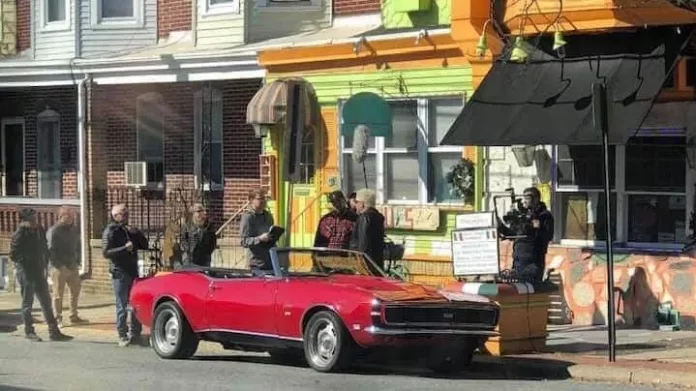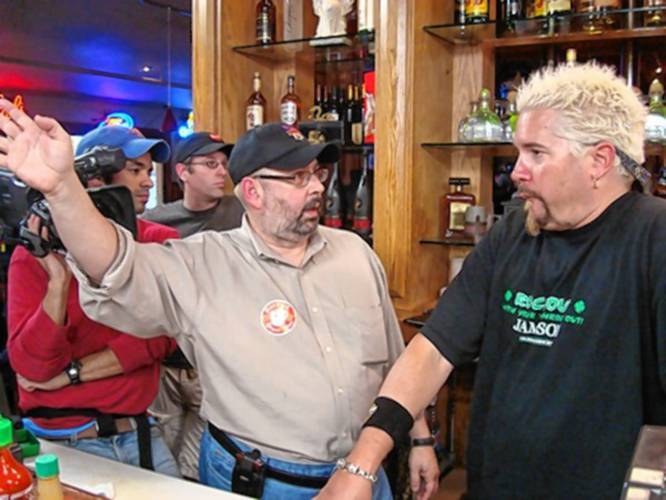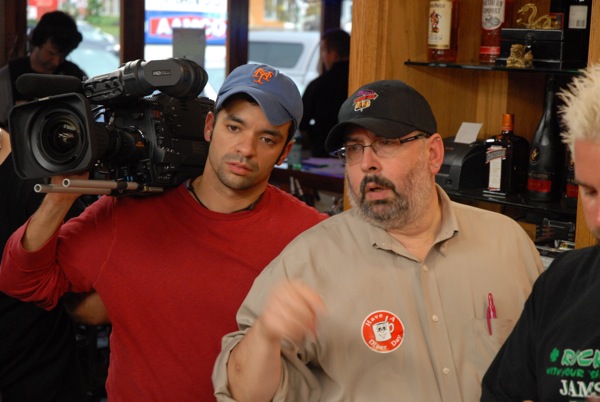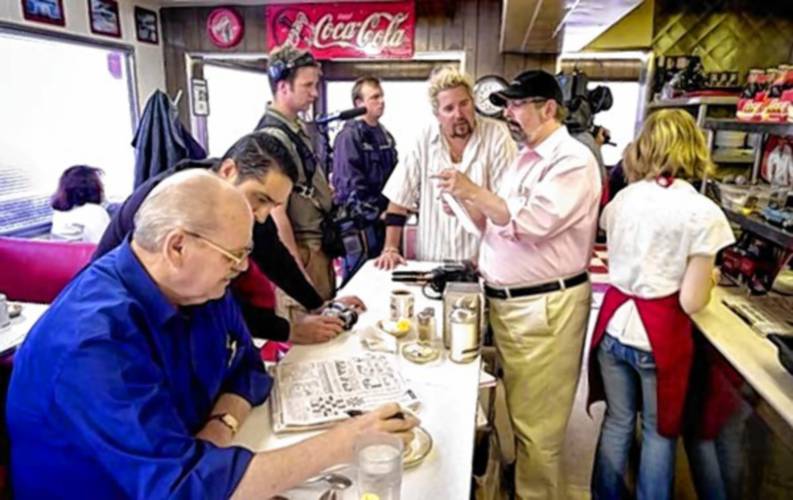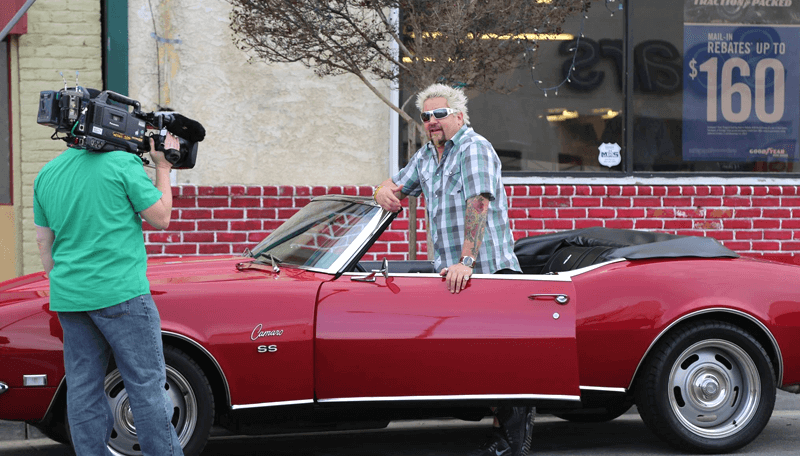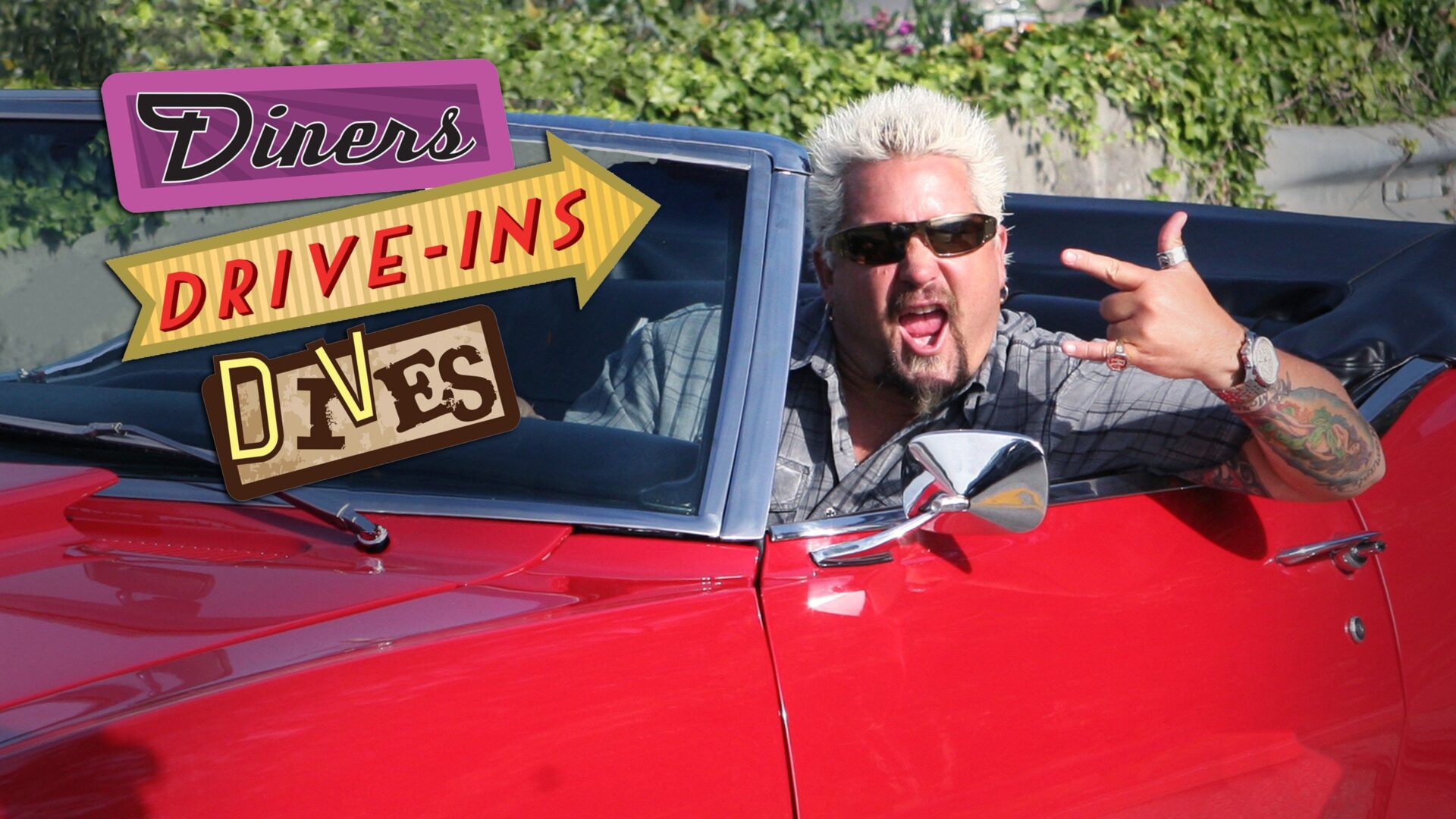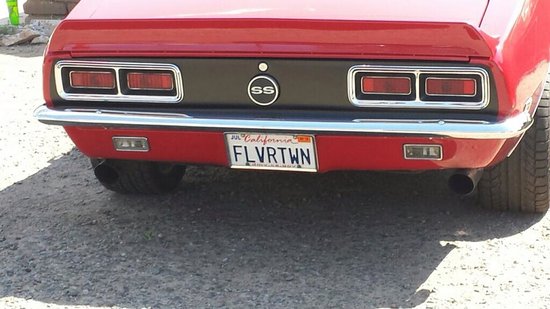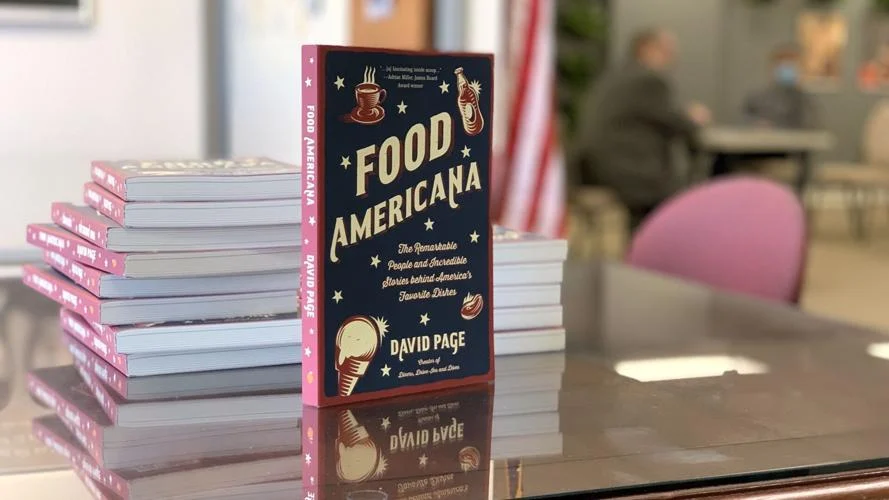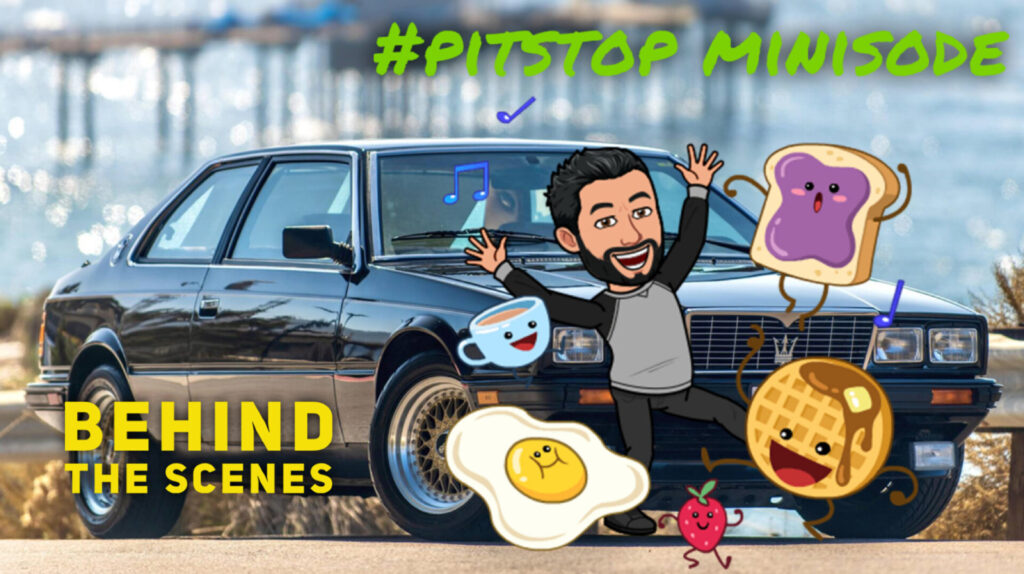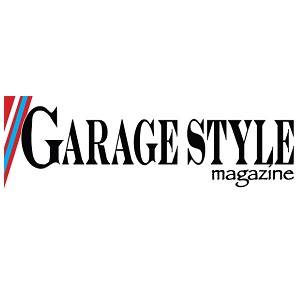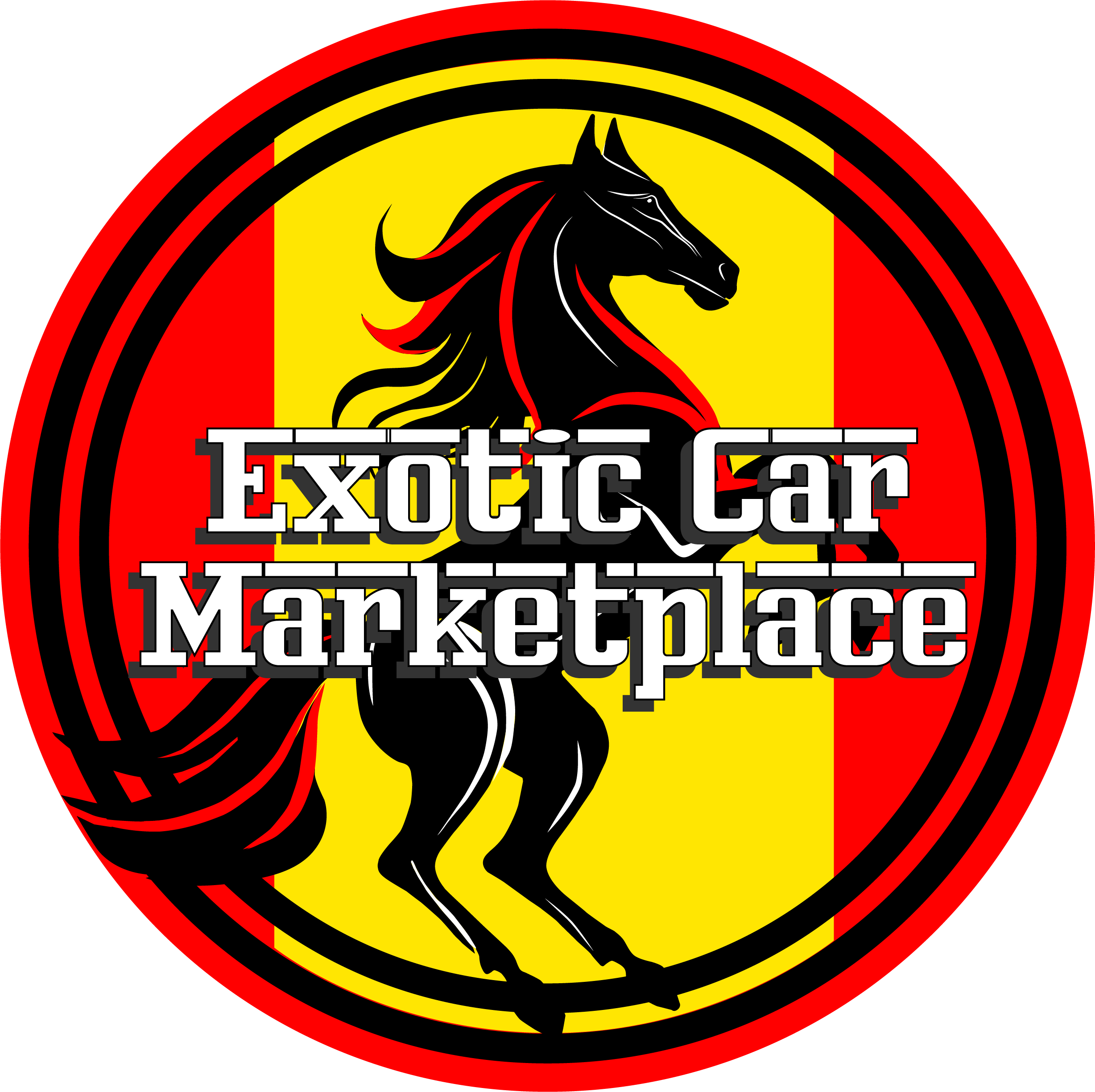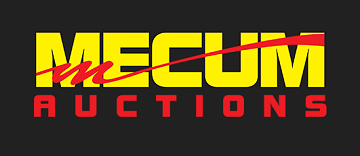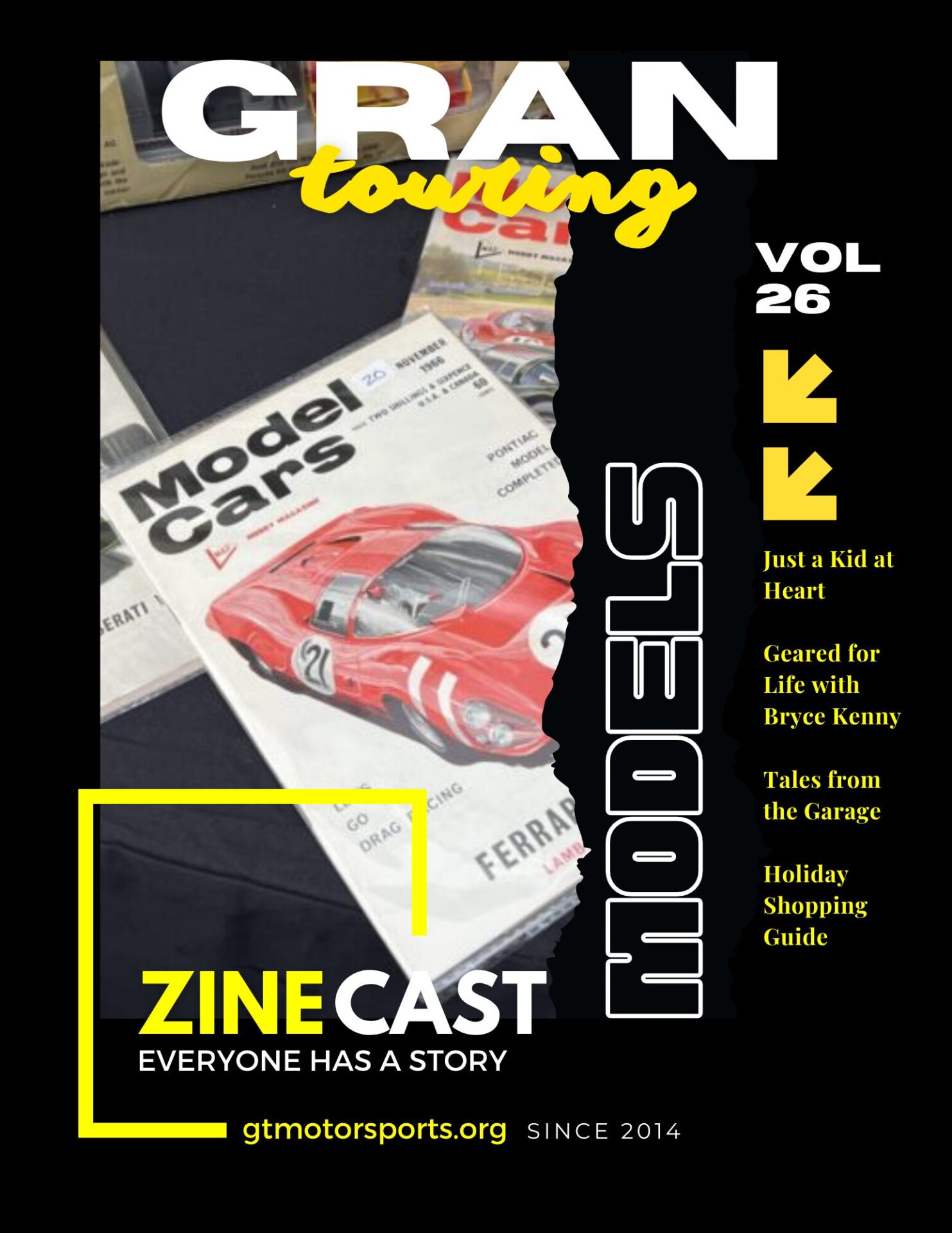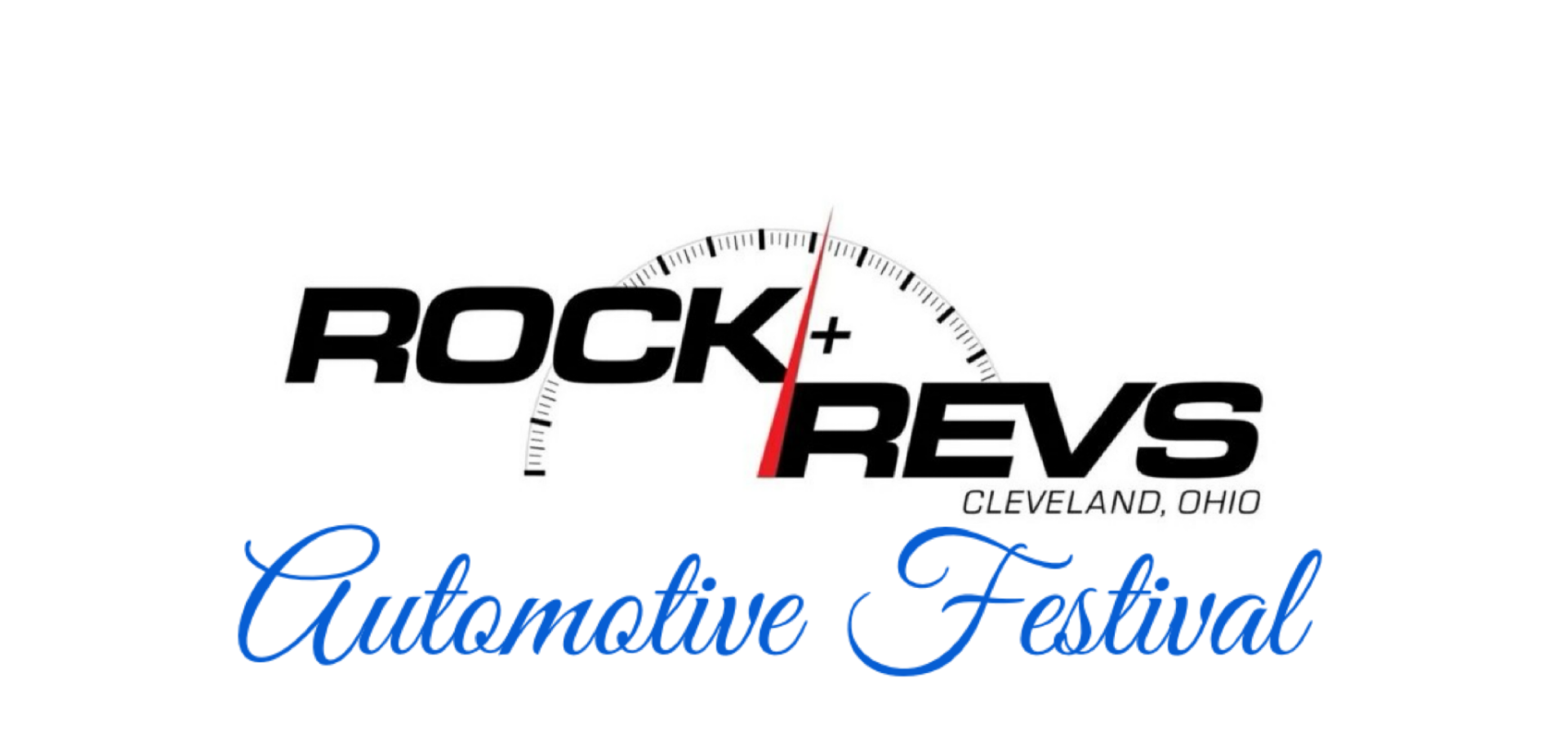Have you ever thought about where Cars and Culinary delights might collide or maybe how both the Automotive and Food industries have had a direct effect on one another? With the help of tonight’s guest, we take a delectable journey through time and taste and explore how the American automobile industry and the tantalizing world of food have intertwined and evolved over the decades. From drive-in diners serving up burgers and shakes to the rise of food trucks cruising the streets, we’ll savor the flavors of innovation and creativity that have emerged from this unique intersection.
Two time Emmy award winner David Page changed the world of food television by creating, developing, and executive-producing the groundbreaking show: Diners, Drive-Ins and Dives. So get ready to indulge your appetite for knowledge as we dish out stories behind iconic cars, the birth of fast-food drive-thrus, and the fusion of culinary culture with car culture, all while exploring how these two American passions have shaped each other in surprising and delicious ways.
Tune in everywhere you stream, download or listen!
 |  |  |
- Spotlight
- Notes
- Transcript
- Highlights
- Learn More
Spotlight
David Page - Author for Creator of Diners, Drive-Ins & Dives

David Page has pursued his passions both personally and professionally. Creating Diners, Drive-Ins and Dives and hands-on producing its first 11 seasons took him deep into the world of American food – its vast variations, its history, its evolution, and especially the dedicated cooks and chefs keeping it vibrant.
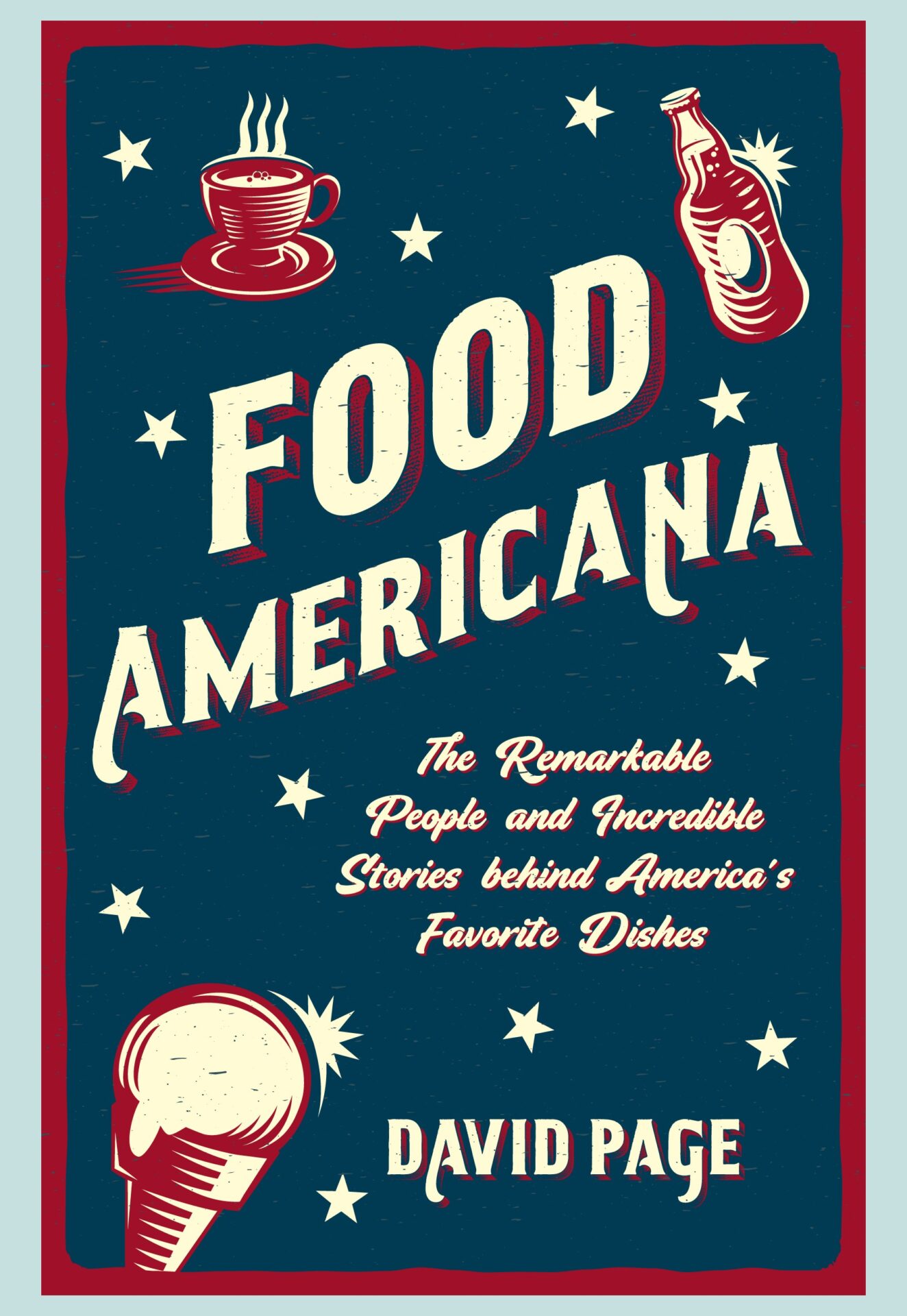
Notes
- How the car industry influenced the Food Industry and Vice-Versa
- How much time do we spend eating in/around/with our vehicles?
- What’s the difference between a Diner, Drive-In and a Dive?
- Cars also gave rise to Delivery (were Pizza Hut & Dominos the first?) how has the EVolution changed this?
- Has anyone ever studied the environmental impact that food delivery has?
- Is there a best car to eat food in?
- With EV charging taking considerably longer; places like Sheetz, Rofo and Wawa are poised to become “eateries” and not just convenience 7-11 style locations.
- On the show (Triple D) Guy Fieri is always seen with the Camaro; why that car? Is it the “most American” – why not a mustang?
and much, much more!
Transcript
Crew Chief Brad: [00:00:00] BreakFix podcast is all about capturing the living history of people from all over the autosphere, from wrench turners and racers to artists, authors, designers, and everything in between. Our goal is to inspire a new generation of petrolheads that wonder. How did they get that job or become that person?
The road to success is paved by all of us because everyone has a story.
Crew Chief Eric: Have you ever thought about where cars and culinary delights might collide or maybe how both the automotive and food industries have had a direct effect on one another? With the help of tonight’s guest, we take a delectable journey through time and taste while exploring how the American automobile industry and the tantalizing world of food have intertwined and evolved over the decades.
Don Weberg: Two time Emmy Award winner David Page. Change the world of food television by creating, developing, and executive producing the [00:01:00] groundbreaking show Diners, Drive Ins, and Dives. So get ready to indulge your appetite as we dish out stories behind the iconic cars, the birth of fast food, drive thrus, and the fusion of culinary culture with car culture, all while exploring how these two American passions have shaped each other in surprising and delicious ways.
Crew Chief Eric: With that, let’s welcome David to BreakFix.
Don Weberg: Welcome, David.
David Page: Well, thanks for having me. It’s good to be here.
Crew Chief Eric: And joining me is one of our regular co hosts on BreakFix, Don Wieberg from GarageDom Magazine. Welcome back.
Don Weberg: Thank you. Thank you. I know. Thank you. You’re beautiful.
Crew Chief Eric: Normally on a BreakFix episode, we’d be investigating the hidden lives of pro drivers or automotive designers asking them the who, what, when, where of their automotive past.
But in this case, it’s sort of like one of Don’s jokes. Two car guys in a restaurant tour walk into a dive bar. Hey. So why are we here? Tell us how we got here. Tell us about how you [00:02:00] created Diners, Drive Ins, and Dives. By accident,
David Page: I’d had a long network news career, been all over the world, show produced at both ABC and NBC, came back to the States, and then I left to open my own production company, which for a while was a license to starve.
I couldn’t sell a show to save my life. There was a programming executive at the Food Network who was at least willing to talk to me. And I’d call her and pitch stuff and she’d politely say no. One day I’m pitching and she’s obviously feeling sorry for this pitiful guy. And she says to me, don’t you have anything about diners?
And I said, oh yeah, I’m developing a show called Diners, Drive ins and Dives. And I told her all about it. And she said, you know, that sounds pretty good. This was like late on a Thursday or late on a Friday. She said, we have a development meeting Tuesday. So get me a write up for a one hour special on Monday.
Hung up the phone. I was pleased that she was interested, but I had a problem because I was not developing a show [00:03:00] called diners, drive ins and dives. I had just pulled the phrase out of thin air and then mumbled for a while about what would be in the show. Fake it till you make it. I guess I spent the weekend calling around the country, talking to restaurateurs, food writers, chefs.
Put together a writeup, sent it in, and pretty quickly they picked up a special. Not that long after they picked it up as a series. Now they weren’t tremendously enthusiastic about it. I mean, after the first few episodes scored well on the ratings, an executive went out of his way to tell me that, look, this looks great and enjoy it, but we don’t figure this has more than a couple of seasons in it because there just aren’t enough restaurants.
Don Weberg: Did you really think you would actually run out of restaurants?
David Page: No, I didn’t. They did. Okay. Understand one of the rules of television is that executives don’t know shit. So it’s like getting notes from an executive. They have to send you [00:04:00] stuff telling you what’s wrong with your piece. Mel Brooks famously said all of the notes he got on blazing saddles.
He said, absolutely, absolutely. Absolutely. And then ignored the ball. Because if he had done what they wanted, the movie would be eight minutes long. I did the first 11 seasons, they’re now in season 40 something, so I guess there are enough restaurants.
Don Weberg: That’s how you invented the show. How was your first meeting with Guy?
Tell me about how he came along.
David Page: First of all, I didn’t meet him until we were shooting. When they picked up the special, I said, well, should we talk about a host? And they said, no, we got Guy Fieri. I said, who the hell’s that? And they said he won the second Food Network Star Contest. I said, what the hell is that?
Cause I didn’t watch food TV. So I Googled him. My first thought was I’m screwed. I mean, here’s this cartoon in flip flops, shorts, and spiky hair. Now our first phone conversation was useful because I was at our beach house, which turned into our full time residence on the Jersey shore, and I was cooking [00:05:00] something that required.
Fennel. I don’t remember what it was. It might’ve been, uh, trepino. Anyway, I got him on the phone, or he called me back while I was out shopping, and I said, I can’t find any fennel. And the first thing he said to me was, use sambuca. Same flavor. So we started off kind of in a foodie conversation. When we first met, it was when we started shooting.
And we began at a small diner in Jersey, across from a refinery in Linden. And the crowd there is, shall we say, homegrown. First of all, I’ve worked with all of them. Brokaw, Diane Sawyer. I gotta tell you, Guy was green as grass, but had, and to this day probably still has, more natural TV talent than anyone I’ve ever worked with.
There’s just something there. He didn’t know Jack when we started, but he picks it up quickly. For example, at the Bayway, he had jumped behind the counter to start serving [00:06:00] food and joking around with the customers, and he kept joking that if he screwed up an order, the Mafia would get him and we’d find his body somewhere.
I finally pulled him outside and said, Dude, You’re in a tough part of Jersey, I wouldn’t make those jokes. And by the way, there’s a guy at the counter who’s packing. So he gave up on those jokes. And I say that as a proud resident of Jersey, those jokes went away and off we went. And it was a great experience.
Don Weberg: I run Garage Style Magazine. And here’s an old, old cover. A hundred years ago when this issue came out, we got an email from a man. He was some sort of producer, handler, something of Guy Fieri, saying he’d come across the magazine. Guy is a good car guy. Can we get his garage in the magazine? It looks pretty good.
So they sent me some snapshots. Really loved what I saw. I said, yeah, let’s put it together. Now the B. Perfectly frank, I’d only seen Guy Fieri on commercials, whatever. I never really watched the show. So my sister calls and she says, uh, what are you up to [00:07:00] the next couple of weeks? I said, well, I’m going up to Santa Rosa, Santa Rosa.
What’s up in Santa Rosa? And I say, well, you ever hear of Guy Fieri? Oh yeah, yeah. I know Guy Fieri. We went to school together. Wait, what? Yeah, we went to school together. You and I’ll be no kidding. So we get up there and yeah, we had a great photo shoot. We put him in the magazine and I’ll put it to you this way.
Very interestingly, he is one of the very, very, very few. In fact, if we go through the issues, we might find he is the only. Human being that I allowed to be in the garage while we shot it. Cause he wanted that photograph of himself with that Camaro. Who’s Camaro is that? The one that’s on the TV show. Is that his?
Well, the
David Page: one that’s on the TV show now is a 68 that right. The production company that followed. After I left the show, they bought that the one that we were using originally I purchased for a stupidly large amount of money because I was in a rush and it was available and it was a 67 although [00:08:00] there wasn’t a single.
Numbers match component anywhere on that car,
Crew Chief Eric: David. We didn’t bring you here to recount all the trials and tribulations of triple D. What we really want to get to crosses the line into your new book, Food Americana and where the automotive industry and the food industry have collided many times over the years.
So let’s kind of switch into second gear now. And talk about how the car industry has influenced food and vice versa. In your book, you talk a lot about how much time we spend eating in and around our vehicles. I can’t get a number for that.
David Page: You know, it’s funny. NHTSA has everything. I did specifically because we were going to chat.
I chased down some stats and what I find fascinating is that my generation, the boomers, Spend the most time eating in cars and quite counterintuitively, Millennials and Gen Z spend less. I would have assumed that [00:09:00] especially coming out of the pandemic, the number would be up. There’s a difference between getting food with a car and eating in a car because an analyst was telling me just a couple of days ago that if you add up quick service restaurants, Takeout, drive thru, all forms of obtaining food.
82 percent of restaurant meals are now takeout one way or another, which is a stunning number when you think about it. There’s another statistic. Half of the time that people leave their house or hotel or wherever they’re staying, 50 percent of the time, they anticipate that food will be part of the journey.
So, the ability to drive to food has been with us for a long time. I mean, look, when cars first came out, there was no thought of driving and eating at the same time because These did not have Rolls Royce like suspensions, but there was an assumption that the car [00:10:00] and the opportunity to eat would be intertwined.
Early cars came with picnic baskets or other similar extras, if you will, that made it possible to pack your food and take it with you. In maybe the forties or fifties, you started to see rudimentary forms of cup holders. I wouldn’t go flying down the highway with them because they were mostly small indentations in the glove box cover.
When it was open, it was in the eighties that. We went bananas, the Chrysler Corporation brought out the first minivan and it had cupholders. And suddenly we were into this era of, I don’t mean this to sound sexist, but it was a term that was used, soccer moms. And everybody’s family having a van, and it became essential to have a cupholder.
At one point, there was a van that had 19 of them, and incredibly, there is a Subaru out [00:11:00] today that has 19 of them.
Crew Chief Eric: It’s funny you bring that up because on the other side of the pond it took the Germans forever to adopt cupholders in their vehicles because of the restrictive rules of the Autobahn. Those
David Page: rules simply mirrored public taste.
I lived in Germany for several years. While I was there, I owned a Maserati B Turbo, which is derided by many these days as a crappy car, but God knows I loved it on the Autobahn. And they just have a different view toward the civilian professionalism required of driving. First of all, it’s much harder to get a license there.
Many American military parents actually send their kids home to get a license in the U. S. that is then recognized in Germany. But they’re serious about, you don’t mess around on the road. That includes first aid, all sorts of stuff. To get licensed. I know when I was working for NBC and the Frankfurt Bureau, we had a couple of regular drivers when we were doing stories in Germany, and these guys had the biggest Mercedes [00:12:00] possible and they drove it at 9, 000 miles an hour, but it was with both hands on the wheel.
And this was taken seriously even today. I mean, I have a Mercedes SUV and it has real cupholders, but the car I had before this was a SLK 55 AMG. And the cupholders in that kind of spit in your face and said, you Americans want to drink in your cars, try using this, and you had to pull this thing out in front of the central air conditioning vents, and then a.
Thing dropped down and you could put your cup in it, but it was like a reminder that if you’re gonna do this, you’re a moron. So no, I felt a very Germanic sense of disrespect when I was driving that car, which was a great car, real fast, no brakes. Now, let me back up one second to talk about why we ended up with cup holders in cars or why we ended up eating in cars.
That was [00:13:00] thanks to the changes in American society that followed World War II. After World War II, for white Americans, this did not apply to minorities. I mean, blacks were not included in the benefits of the GI Bill. But for white Americans after World War II, this was Katy bar the door. Everyone seemed to have a ton of money.
We had won. We were great. Everything was possible. Science was the future. Among other things, under Eisenhower, we started to build interstate highways, and that facilitated something called a suburb. People started leaving The urban areas because they could afford cars and the American dream was now outside of the center city, which resulted in people commuting to and from work, and that fostered a growing dependence on the drive in or the drive through, and it all escalated from there.
[00:14:00] But it was the move to suburbia. That put us in our cars for all of those hours and while you’re in a car you might as well eat.
Crew Chief Eric: As the interstate highways increased and parking is also part of this equation too, how that’s changed and evolved. Cities versus urban sprawl versus suburbia and things like that.
In the older days, the cities, people would walk to restaurants. Like you can still see a lot of those old downtowns where you walk up to a diner or dive or whatever. My
David Page: daughter lives in New York City. We walk to restaurants.
Crew Chief Eric: Exactly. Would you say the turning point was really the real estate game that Ray Kroc was playing with McDonald’s and how that introduced these larger parking lots, people driving through, driving in, as you were describing?
David Page: To some extent, I mean, look, Ray Kroc didn’t invent fast food. That was done by the folks at White Castle back in the late mid twenties. But yes, Ray Kroc figured out how to take the concept broad. And what it took to get [00:15:00] there, and you’re right in referring to it as real estate because McDonald’s makes, as I understand it, most of their money from renting the land they bought to the operator of the restaurant.
And yes, the ability to park, the ability to drive through, although it’s interesting because initially drive in was not a drive through. It was a place you drove to and then sat in your car with a tray on the window, eating and drinking, sort of like American graffiti. The concept of driving through took a while to catch on, and it continues to grow every year.
The pandemic had a lot to do with increasing the degree to which we are comfortable doing that. And broadening the restaurants from which we get our food that are now willing to fulfill that need. But yeah, I mean, it was Ray Kroc. I’ll give you that.
Don Weberg: I live in Texas now. I was born and raised in Los Angeles.
You talk about urban sprawl and the [00:16:00] highway system. That all started right there in California. There’s a town in New Mexico, and it still has its original McDonald’s. They were the first drive through in at least all of New Mexico. I don’t think the U. S. Relevant. Yeah. And the whole reason for it was they were losing sales.
And how were they losing sales? Well, the town is supported by a military base. And the rules of the military base are you can leave the base in your car, but you can’t get out of your car if you’re in uniform. So if you want to eat. You can’t go into McDonald’s. So McDonald’s responded to that by building the drive thru.
That way the men and women in uniform, they could go through a drive thru, pick up some food, and they’re on their way.
David Page: You know, it’s interesting. Texas arguably had the first drive in.
Don Weberg: Is that right?
David Page: Yeah, the pig stand barbecue and hamburger restaurant of which I think maybe I’m wrong. I don’t know if there are any left.
It was generally credited as the first drive in, I believe.
Crew Chief Eric: We’ve talked already throwing out a lot more than [00:17:00] just the triple D’s. There’s other ones out there too, but for the audience, what’s the difference between a diner, a drive in and a dive?
David Page: Well, I kind of have to retroactively define it. Cause as I said, I pulled the name out of my, you know, what being serious about it, a diner historically is a privately owned restaurant with a massive menu that does legit home cooking quickly.
and cheaply. A drive in is McDonald’s, the pig stand, any bunch of places that are in anyone’s town growing up where you drive the car there and you can eat sitting in the car in front of the restaurant. A dive is where you go when you’re drunk and you need grease. So that’s the definitional difference.
Crew Chief Eric: Let’s switch into another section I’m going to call delivery Or
David Page: DiGiorno, so
Crew Chief Eric: as cars changed, got bigger, evolved, added things [00:18:00] like cup holders, other amenities, probably even changed the design of their door cards and their door frames to accommodate for the drive ins and things like that. They also gave rise, thanks to two big fast food chains, which were Pizza Hut and Domino’s to this concept of delivery.
Now we have things like DoorDash and whatever. But we can also begin to talk about the evolution, as we like to call this, the introduction of EV cars into this whole concept of delivery.
David Page: First of all, delivery was not invented by Pizza Hut and Domino’s. They’re the ones who took it. And I’m trying to remember who was first.
I think it was Domino’s. But. There were independent pizzerias doing delivery. It was whichever of these chains came up with it first and then the other followed that turned it into a nationwide expectation. From there it grew. Chinese food being deliverable, although that actually started in urban settings where a car wasn’t involved.
It was more likely a bicycle. But yeah, we [00:19:00] came to expect delivery, although we associated it for the longest time with second rate food. With all due respect to people who’ll tell you that Domino’s or Pizza Hut are food, they’re not. They’re some sort of polymer from Mars. Increasingly, as the need arose specifically around the pandemic, the concept of good food being delivered kind of invented itself.
And nothing happens overnight. There were delivery options throughout the years. I guess DoorDash and Uber Eats and such may have existed before the pandemic. Probably not Uber Eats, but probably DoorDash. Anyway, it was the pandemic that basically… took higher end food and made it deliverable. Is that good?
I guess. If you’re going to eat good food and you don’t want to cook it, I guess that’s fine. I mean, you pay a price for delivery. It doesn’t appear to be going [00:20:00] down, but we are as a society, especially after the pandemic, into a sense of affordable luxury. It’s like, I can’t redo the kitchen, so I’ll get a granite countertop on the island.
People want a sense of pampering themselves. Uh, I’m preparing a speech to the. Regional Convention of the International Council of Shopping Centers. Hey, they booked me. So I’ve been looking into some of the statistics around delivery and food. And one thing I found in my research is analysts are now saying that when it comes to retail, food is the new apparel.
Consumers are cutting back on things like clothing, but want to pamper themselves with a feeling that they’re enjoying elevated food.
Don Weberg: There’s a Richard Gere movie out there, and I’ll be darned if I can remember what the title is.
David Page: I’m sure the title was, I’m really good looking and women love me.
Don Weberg: Don’t forget, I’ve never met a mirror I didn’t love.[00:21:00]
David Page: Well, there’s that too.
Don Weberg: He’s a better
David Page: actor than you give him credit for, but anyway, you were mentioning a Richard Gere movie.
Don Weberg: The quote that he used in the movie, and it’s always stuck with me, was, food is the only art that nourishes. And I’ve always loved that quote, food is the only art that nourishes.
And if you think about that, it’s kind of true. And it goes a little bit hand in hand with what you’re saying that people want to treat themselves these days to me. And maybe I’m wrong. I just kind of want to get your thoughts on this COVID really turbocharged. Those food delivery services. Yes. And I think in a way because we couldn’t go out We couldn’t go to a restaurant.
We couldn’t go wherever so we had to have it brought in It’s become one of those luxuries that is now Much more of a necessity
David Page: it allows you to perceive it as luxury and by the way The same is true of cars for people who like cars Sliding into a Porsche, or when I had that much dried Maserati, given the change in exchange rates I bought [00:22:00] used and sold used for the same 12, 000 American,
Don Weberg: it felt
David Page: good.
There was some real wood, there was some leather. Unlike EVs, when I stepped on the gas, I heard a roar. It made me feel good. And again, I spent 12 grand on that car. I didn’t spend a hundred and whatever. There are things that nurture the soul. Now, not everybody gives a damn about cars. There are people who just couldn’t care less and that’s okay.
But look, my first car was, no, my second, my first car was a 67 Comet convertible. My second car was a Camaro. And when I smashed it up, my third car was a Camaro. I’ve always been a Camaro guy, not a Mustang guy, because Mustangs were Comets, and Camaros at least had something going for them. But they made me happy.
It’s what do you want to be surrounded by? What can you add to your life at a reasonable price that makes it… In your view, [00:23:00] better food does a lot of that cars do it. For some people, it’s interior design. For some people, it’s a hike in the woods. It’s whatever generates some dopamine.
Crew Chief Eric: We sometimes make light of the progress that’s being made on this new technology of cars and how it’s going to become like Johnny cab, and they’re going to be faceless, nameless personless vehicles.
Companies like Amazon and others have already experimented with drone delivery and things like that. And now you’re seeing that Domino’s, they’re publicly commercializing the fact that they have EVs in their fleet. They’ve got their own cars. It’s no longer, you know, a high school kid with his mom’s Honda Civic delivering your pizza.
They’re in a Chevy Bolt. How is that going to change the restaurant business as they get deeper into EVs, self driving cars, maybe even potentially autonomous vehicles? Do you see that having an impact on the restaurant business?
David Page: I don’t believe many restaurant owners operating on a 5 percent margin are going to risk the [00:24:00] insurance payments for autonomous delivery.
It’s going to be 20 years at least before America trusts autonomous cars. As for EVs, it’s just the next step. The thing that’s holding that back from broad acceptance nationally is lack of charging stations. I guess if I’m a restaurant, I can afford my own charging station for my own fleet. That’ll continue to grow, especially given the fact that delivery is, you know, you’re not going 400 miles, but I assume you could charge an EV, give your delivery driver the keys.
He’s out for the entire evening. He comes back, puts it back on charge, and it’s ready to go tomorrow morning. That seems to me, one of the most reasonable applications for electric vehicles. It’s going to be harder that on the way from here to visit some friends in Michigan, until I’m comfortable that I can really recharge the battery and that I don’t lose an hour of travel time.
When I do, I’d love [00:25:00] to have an electric car, but I’m not ready yet. It’s not consumer friendly enough in my view.
Crew Chief Eric: Well, we’re going to put a pin in that thought and unpack it as we move along here. I don’t remember which restaurant chain it is, but they’re also positioning, you know, be a superhero, come and do takeout again, come pick up your own foods.
We’ll pay you to not have to deliver it. Right. But we’re still putting cars on the road one way or the other. Oh yeah.
David Page: No, that’s not going to change. Look. The carbon footprint of pickup and delivery, I haven’t seen a number for it, but I’m sure it’s pretty big. Then again, just to be contrarian, nobody has told me what the carbon footprint of making batteries for electric cars is or generating the electricity that those batteries hold.
So I’m not convinced that the savings are as great as anyone claims them to be. Theoretically, I guess electric cars are better. And since that’s where we’re going, that’s where we’re going.
Crew Chief Eric: And I’m glad you brought that up because it’s been something that was top of mind even after reading your book, which was the environmental [00:26:00] impact of takeout and delivery.
And it’s part of the equation that we really haven’t looked at. And we talk about the environmental impact of a lot of other things and how we should be doing more mass transit, but when it comes to food, there just seems to be this exception to the rule. Well, yeah, but there’s also an exception to the rule going to work.
David Page: I mean, there are certain parts of life where. In the public mind, the downsides are put in the closet because that’s just how we do things. With all due respect to the governments of Southern California, you’re not going to get in the short term a whole lot of Angelitos. To try taking the bus. It’s just not in their DNA and the city isn’t set up for it.
There are similar problems in the New York area. Robert Moses, who was in charge of building virtually everything for a very long time, was a noted racist. And built the center medians on the [00:27:00] suburban New York parkways to be too narrow to fit mass transit because he didn’t want minority populations finding an easy way to commute from the suburbs.
It’s always something.
Crew Chief Eric: So you touched on this before how the interstate highway system post World War II, the Eisenhower network of roads changed food, right? It opened us up. We could go to other cities and other towns and other places to experience the culinary diversity that’s out there. You could take barbecue as you talk about a lot in the book, and it’s just geographically different depending on where you are, what the taste is going to be like, things like that.
So the interstate highway system opened that up. If you’re going to take a road trip, what are the top five places to drive through and have a fantastic meal?
David Page: Those are not necessarily the same thing. I’m going to tell you places you want to go. You got to go to Maine for lobster as it should be consumed.
On the way back down the coast, you have to go to [00:28:00] Massachusetts to Ipswich for whole bellied fried clams, which are not clam strips. When you continue south, you need to go to the Carolinas for whole hog barbecue. You then need to go to New Orleans for every single damn thing that they sell. Then you’ve gotta head way north to Chicago for Italian beef.
And Polish sausages served at a place called Mr. Beef, which was the restaurant that they ripped off for the show, the bear. And which used to be just down the street from the merchandise Mart. It’s still there. NBC left the Mart, but when I was at the NBC bureau there, the bureau lunch every now and then it’d be to walk down the street to Mr.
Beef, sit on the pigeon shit covered tables outside and chow down. Let’s see. How far have I gotten? I’ve gotten to Chicago. I would zigzag back down to New Mexico [00:29:00] for anything involving green chilies, probably a green chili cheeseburger, into Texas for Central Texas brisket barbecue, over to L. A. for Mexican American street food, And then up to Seattle for anything involving salmon, and then I’d rest.
That’s David’s one
Crew Chief Eric: lap of America right there, you like that?
David Page: What the hell, why not? And I’ve missed, you know, 90 percent of all the good places, but…
Crew Chief Eric: True, and there’s a lot of them, and there’s plenty of awesome drives and foods to experience out there, and it’s kind of funny… Don and I were recently out in Monterey for car week and talk about an area of the world where food is everywhere.
And the drives are amazing. The same can be said up in the canyons of LA and Malibu and Santa Monica.
David Page: If you’re going to drive a Pacific coast highway, then get yourself up to Santa Barbara for some tri tip barbecuing. The only other place that I know of that uses that particular cut of [00:30:00] meat is Argentina.
Of course, in Santa Barbara, they put it on this. Wood fired barbecue where they literally they have a wheel and they control the temperature by moving the food up and down in terms of its proximity to the fire. It’s not barbecue. Barbecue is not grilling. They call it barbecue. It’s grilling. Barbecue is really low and slow over indirect heat.
Except when it’s not like at the rendezvous in Memphis, where they cook their celebrated ribs directly over the heat in a converted coal chute. Every rule is meant to be broken, but there you go.
Crew Chief Eric: And I’m glad you brought up tri tip because that was one of the things we were talking about while we were out there.
And I was telling Don, I’m so excited to go to the track for the Monterey Historics. And he’s like, oh yeah, you just want to see old race cars. It’s like, no, you don’t understand. I can get one of the best tri tip sandwiches at the racetrack. And I’m looking forward to that probably more than anything. And he was just kind of put his head in his hands in disbelief.
Yeah, no, it’s a cut that doesn’t [00:31:00] exist in the rest of the country. Getting back to our discussion about cars and food and how cars have changed in this and that. And, you know, we were talking about drive thrus earlier, and I’ve noticed as the drive thrus have been remodeled. Dimensionally, they have changed to accommodate the fact that the best selling vehicle in North America is the Ford F 150 and me and my lowly Volkswagen have to reach up through the window to get my takeout.
David Page: Yeah. You’ll also notice that the newer architectural models of quick service restaurants include many more drive thru lanes. And many of these companies have now come out with models that only have drive thrus and convenience stores. Which are making a big play to beat the QSRs at their own game are now starting drive thrus.
Wawa, the famous chain here in, in Jersey, apparently is planning to open a place in Florida, not that far from Tampa, that is drive thru only for food. May not be only, but it’s intended to sell food and they will have a [00:32:00] drive thru. What they will not have.
Crew Chief Eric: There was something very entertaining in the book.
David Page: Well, thank you.
Crew Chief Eric: Well, there were many things entertaining in the book. At least one. That one part. There was something I picked up in the book, and it’s on page 111 for anybody that’s reading it. And you talk about…
David Page: Hold on. Page 111, you said?
Crew Chief Eric: You referenced foods that are ideal for eating in the car, and you made reference to the bagel being one of the best grab and go foods for a car because it has no crumble.
So is that the only food that really doesn’t make a mess while you’re eating, or are there other things that you would consider eating in your car?
David Page: There’s extremes. The food that is ostensibly eaten in the car… That, in my view, is impossible to eat in the car, is In N Out burger, double double animal style.
It’s a double cheeseburger, two patties, two slices of cheese, covered with [00:33:00] basically chopped lettuce and some version of Russian dressing, in an insane amount. And there is no way to bite into that without wearing it. On the other hand, it may be on a given day, the greatest single food item on earth. When I was last out in California shooting, we went to In N Out Burger four nights in a row and ate sitting on the hood of the car.
And we didn’t mind sitting on the hood cause it was a rental car. And if we dented it, you know, the hardest one to eat is in terms of quick services, Taco Bell. Cause that garbage just falls all over the place. The bagels good, a donut’s good. Anything substantial is fine. The bacon, egg, and cheese that is a staple here in Jersey.
I mean, in New York, it’s a staple, but you eat it walking down the street. The bacon, egg, and cheese is perfect for a car. If you get up with a good, strong Kaiser roll, you need something to hold onto that won’t fall [00:34:00] apart. And you have to be careful with how much ketchup you put on a bacon, egg, and cheese, because that’s where you nail yourself.
You can’t eat something like a scone. Cause it’s just all over the place. You can’t eat something that involves chili cause it’s all over the place. Now you can do what I do, which is to drive with my wife and the other seat. And she’s in charge of like taking the bacon, egg and cheese out and taking a half of it and putting the wax paper around it and giving it to me.
At which point. I immediately discard the wax paper and the ketchup falls on my shirt, but an attempt was made.
Don Weberg: So she’s the pro when it comes to eating in the car, sounds like.
David Page: My wife is the pro in terms of everything.
Don Weberg: Ah, just ask her.
David Page: I’ve been married for 30 years and she’s in the kitchen listening to this, so.
Oh, she just said it, I am not. Okay.
Crew Chief Eric: Well, the inverse of that question. Let’s look at the best car to eat food in. It probably isn’t the Maserati B Turbo. It’s probably not a 911, but it [00:35:00] also can’t be a van or a limousine. So in your opinion, are there cars you’re like, man, this is a great place to eat a sandwich.
David Page: The great car for eating in is we have a Mercedes GLE 350. It’s the larger two seat, two bench SUV. It’s a perfect road trip car. It’s fast, it’s comfortable, it’s got good cup holders and the console in the middle is big enough that if you’re on your own, you know, it’s got the two doors that open on top of the console.
You can actually put like fries in there and the burger next to the gear shift on the console. And you got a pretty self sufficient eating environment.
Crew Chief Eric: Is there a favorite road trip car that isn’t the Mercedes? Something you really like.
David Page: I hate to say this, but I’m in love with that Mercedes. I mean, we bought it off lease.
It was the first year that they came out with the supposed one piece big infotainment screen. It’s a great car. When I had the AMG. That was a great car for making time and it was comfortable, but [00:36:00] now for me, a road trip, if it involves other people, you need room, you need to be able to keep supplies in the back, you know, extra water and stuff.
Crew Chief Eric: And napkins.
David Page: No napkins go in the console and in the, uh, well actually in the, to the left in the door pocket, you can keep napkins and hand sanitizer for when it’s all a little too much. The best car for a road trip is anything you rented, because every wrapper goes in the back seat. If you really want to do an Animal House style road trip, you go to Wawa, you buy all this garbage, and then, you know, you just unload it behind you as you go.
In fact, for the next book, I spoke to the guy who owns a company that manufactures packaging. For products sold at convenience stores, the package is a plastic cup shaped item that fits in the cup holder. And you can fill it with nuts or M& Ms, different companies do different [00:37:00] things. But he makes packaging specifically for non liquids to go in the cup holder.
Crew Chief Eric: See, Don, David hit on it. I’ve been saying forever, no one aspires to own a rental car. Oh, God, no. I’ve always wondered who buys a car from Hertz. Well, David, you mentioned something earlier that I wanted to expand upon, and I said we were going to put a pin in it. Now it’s time to pull that pin out of the corkboard and talk about places like Wawa, Royal Farms, and Sheetz.
You made mention about these convenience stores kind of becoming restaurants, destinations to be, and this actually ties back into the conversation of EVs as well, because to your overarching point, if I got to sit around for an hour, I need to find something to do for that hour. So why not go to what used to be a service station, hang out there, get a meal.
Let’s talk about how those locations, which weren’t originally associated with Hey, let’s go to Sheetz for dinner. Now are these sort of meccas, these places you do want to spend more time and how they’ve changed the [00:38:00] quality of their foods.
David Page: I think you mentioned in an email that Sheetz has seating. Most of the convenience stores still do not.
I don’t know about Casey’s, which is famous for their pizza. In the Midwest, they may have seating, but that is the next step that is still not really being discussed by most of the convenience stores. They’re busy right now trying to convince you that their food is as good or better than McDonald’s. And they’re doing a pretty good job of it.
I mean, while you get mashed potatoes, if you want mashed potatoes, they just announced a big pizza program. They’re retrofitting 900 locations to start with pizza ovens. So yeah, they are vastly expanding their place. In the food convenience universe, and they are taking potential sales from grocery stores who are also at this point becoming more and more what’s called a gross salon, where [00:39:00] they’re selling prepared food.
And in some cases you can eat it there. I can’t predict. I’ve read nothing about competitors to sheets adding seating, but it would not surprise me. I mean, it’s obviously the next place to go.
Crew Chief Eric: And I pick on them only because where I live, I’m very fortunate that I have all three within close proximity of one another.
So it’s very easy to do a case study and compare. Well, all three, you
David Page: have sheets and who else?
Crew Chief Eric: ROFO and Wawa within a couple of miles of each other. Okay. And who’s got better food? There’s the dilemma. You go to ROFO because you want the chicken. And you go to Wawa because you want that breakfast sandwich or that sub or whatever you’re looking for because Wawa’s got that delicatessen almost style to it sometimes.
Or you want that, you know, turkey dinner wrapped in bread they serve. But Sheetz is sort of like, to your point, it’s like a grocery. I go in there. It’s got the cold case. It’s got shelf stable stuff. It’s got non perishables. It’s got a little like mini ice cream parlor. It’s got almost like a mini Starbucks in it.
It’s got all these [00:40:00] options. And as my kids like to joke, it’s the place I can fill up my car and fill up my belly on a whim. And I’m not locked into, well, I only serve chicken. I got all these options. If I want a chicken sandwich or I want sliders or I want a salad, I just go to the touch screen and it’s MTO, right?
Made to order.
David Page: Yeah, it’s made to order to the extent that a bunch of pre prepared ingredients are put together. I mean, there’s a lot of microwave usage at all these places. Oh yeah.
Crew Chief Eric: Oh yeah.
David Page: But you know, it’s like Casey’s famous for their pizza. It’s not like they’re making the dough on side.
Don Weberg: No, but David, they warmed it up just for you.
David Page: Well, let’s say, hey, listen, the big thing in the bagel world is something called par baked bagels. Go into your local bagel shop and you smell the wonderful smell of fresh baked bagels coming out of the oven. Well, they were 90 percent baked. At a manufacturer and then they were frozen and sent to Bob’s store and Bob put him in his [00:41:00] normal oven.
You know, he didn’t have to boil the bagels. He just heats them up and you have them. They’re not bad. They’re better than lenders, which owns much of the retail bagel market. Although the number one seller of bagels in America is still Dunkin Donuts.
Crew Chief Eric: Surprisingly enough.
David Page: Well, hey.
Crew Chief Eric: But where I’m going with all this is.
I feel that sheets is taking a step in a direction that maybe others will follow. And you’re to your point, it’s not McDonald’s or Wendy’s chick fil a or whatever, it’s somewhere in the middle between your fast casuals, your Panera’s and your blaze pizzas and stuff like that. And I’m not sure there’s a category for what they are yet, but I do like the grosser on kind of idea you’ve got going on there.
David Page: However, understand something from a financial standpoint, the ability to sell food attracts customers. And increases sales per square foot. When you start dealing with additional real estate costs for what is in essence, dead space for people to sit there [00:42:00] and eat when let’s face it, you’re not offering them the most conducive environment.
I’m not smart enough to know where the graph lines cross there.
Crew Chief Eric: Having visited European countries and you spent some time over there yourself. They have these concepts of these rest stops. Like we do on the New Jersey turnpike is famous for all the rest.
David Page: No, you’re the, the auto strata restaurants in Italy are the best.
Exactly.
Crew Chief Eric: The outdoor grills on the auto strata are fantastic. Go in there and chefs. And it’s like a restaurant and you sit down, you bring up your tray. I’m not worried that my Tesla is outside charging for the next hour because I’m having a home cooked meal while I’m at the gas station, right? So I’m wondering if we’re going to eventually catch up, somebody will step out from a Sheetz or a Rofo or a Wawa and say, we’re going to do what the Autogrill does.
And I saw those even this year, when I went over for Le Mans, a lot more of those types of things were popping up in France and in Denmark and other places in Europe, modeling that Italian style of that roadside turnpike [00:43:00] side restaurant.
David Page: And I guess you’re predicating this on having to recharge your EV.
So, this isn’t going to matter until there are enough EVs that you’re going to get enough of a customer base from those recharging them to justify the expense. Secondarily, unlike Europeans, we constantly want to get where we’re going. I don’t know how many people on a road trip, if you’re me, you’re calculating how many of the 12 hours you can do in 10.
How many of those people are going to say, well, I got good momentum here. Let’s just sit down and have a leisurely meal when you can drive through and then throw the wrappers at your kid in the back. And again, so much of this is predicated on guessing human behavior. I don’t know again, at what point those two lines cross, if I have to recharge my Tesla.
Crew Chief Eric: We could maybe agree that it’s going to change. The [00:44:00] way we think about food because our travel is going to change. If the market saturation of EVs continues to climb the way it’s been doing.
David Page: Call me when that happens. No, I, you know, I don’t want to be negative, but I don’t know as someone who’s been immersed in the food world for quite a while.
How important that quality of food is going to be to folks on a road trip, for the most part, throughout the American population?
Crew Chief Eric: Well, I guess we’ll have to find out. Nobody knows the answer. I guess we will. I would personally like to see it elevate itself, because if I am going to sit there for an hour, I want more than just a burger, maybe, to choose from, right?
David Page: Yeah, but I don’t want to sit there for an hour, so by the time I get an EV, it’s going to have the kind of range I need. That’s true. And I can get where I’m going. Without having to sit for an hour, because until I don’t have to sit for an hour, the EV is not for the average American. They’re forcing us there in terms of legislation.
And I do see more and more charging stations popping up. What I would [00:45:00] not be comfortable on a long road trip having to worry about where the next charging station is.
Don Weberg: Now, interestingly, you guys are both talking about how great Europe is. Because they’ve got all these wonderful restaurants on the side of the road.
They have Chef Pierre over there going to create you a croissant. He’s going to do something wonderful. And yet, flip side of the coin, both of you are lamenting on, I don’t think I want to spend an hour waiting for this. So are the European places quicker? Are they more efficient than we are here in America?
I’ve only been to restaurants on the auto
David Page: strata for some reason. I don’t recall restaurants on the autobahn. They were like cafeterias in that they were still quick serve restaurants. You could get in and out in 20 minutes if you wanted to scarf it down, but it was a higher quality of food unquestionably.
Don Weberg: What you’re kind of describing is interesting to me because living in LA. Family in Las Vegas. We were hitting that 15, four to five times a year. At one point, [00:46:00] one day we’re driving along up there and we noticed a new place being built. No wonder what that is. Two months later, we’re driving back to Vegas and there it is.
It’s built. So we got to stop. We got to see what this is all about. Giant, huge ice cream is standing off the side of the road. And it says. Eddie world. Have you heard of this place? No, Eddie world within what is this? We got to go see this place. So we pull off the road and there they are bank upon bank upon bank of car chargers right to the side of them.
Of course is fuel fill up stations. Not only do they have that, but they have the spray bottles so you can clean your windows properly. They have the lavender scent. They have the orange scent. You can spray those in your car to get rid of the scent of road trip that we all love. You go inside. There are seven or eight different eateries in there, and each one of them is independent.
It’s not like they’re all owned by Eddie World, they are independently operated. And what’s interesting is what you guys are saying about the Europeans. I’m sitting here thinking that’s what Eddie World is doing. They have these different little eateries where you [00:47:00] can go. The food is not bad. Granted, it’s not the best, but it’s not bad.
Where their hook is. And I think anybody listening will appreciate this. Cleanest bathrooms on Highway 15. Cleaner than Bucky’s? Ah, let me get to that. Okay, so Eddie World literally has a staff. And this staff, the whole job is bathroom attendant. They literally switch from side to side. You have two men’s room, two women’s room.
They’re cleaning one, then they’re cleaning the other, cleaning one, cleaning the other. And they go back and forth. It’s like painting the Golden Gate Bridge. You go down one side, You flip over, you go down the other, you come back, you go, you just keep doing it and you keep it clean. It works really, really well.
Now, Eric brought up Bucky’s. So we have that here in Texas. It was the first time I’d ever seen it was when we moved here. It was a really, really similar concept, except. I don’t think they have the dedicated bathroom staff and that just turns me off. But what you have is a huge shopping section there for all kinds of touristy stuff.
A big selection of barbecue or [00:48:00] what you were referring to earlier as kind of frozen foods that become edible later on, thanks to a microwave. And it’s really, really interesting to me to watch this. All of it’s revolving around, boy, my Tesla. My maki, it’s out of juice. I got to plug it in. That’s going to take a little while.
So it goes to your point of, I see a clash coming up. Americans have always prided themselves as being efficient.
David Page: No, we like to say we’re efficient, but it takes us 40 hours a week plus bring and work home to do what the French do in 36 hours.
Don Weberg: This is true, but in serving the world, we’re also serving the motorists of the world, aren’t we?
So it’s interesting to me to listen to you guys, talk about the European way of doing it and thinking to myself, isn’t that wawa isn’t that what they’re kind of doing, it’s just, I guess it’s a quality of food. That’s a little, it’s a quality
David Page: of food issue. The place on the auto Strada is closer to an American diner in that the food is actually cooked there.
That’s all now you can pull off an American highway and go to a diner. And [00:49:00] enjoy the same thing. And you can also be out in 20 minutes. So those places exist and they’re great. Or if you’re going to Vegas, you can pull off 15 at, uh, I think it’s Death Valley and go to the Mad Greek. Oh yeah. That’s an extraordinary restaurant.
They make their gyros from scratch. Yes. It’s not that stupid cone of junk. It’s actual food. We did a piece on them on diners. Now, does the Mad Greek have EV charging stations? I would hope so, because in its day, it was the only tourist attraction on that stretch of desert.
Don Weberg: Yeah, that town is called Baker.
David Page: That’s right. Yeah. And then they have that big thermometer, right?
Don Weberg: Yeah, that’s their big draw. In fact, I don’t know if it’s still for sale or not, but just a few years ago, you could have bought the Baker prison. Damn. I know. You missed your chance, man. You
Crew Chief Eric: know, time is everything.
Don Weberg: It is. It is
Crew Chief Eric: David. You hit on something really important there.
You could go [00:50:00] to that Greek restaurant and kind of go off the beaten path.
David Page: It’s right at an exit,
Crew Chief Eric: but you said, well, maybe they have a charger for me there. And if they don’t, then there’s the dilemma. I want the really good Euro, but I still got to charge my Tesla. No, they’re going to, they’re going to need a charger.
Where I’m going with this is. We are now creating a new type of competition between the restaurant tours and let’s say a sheets or a rofo or a Bucky’s or whatever, where it didn’t really exist before everybody knew their place in the pecking order. You went to the gas station to get gas and you went to the restaurant to go eat, but now when the gas station becomes the restaurant, how much business in turn are these restaurants going to lose?
And when do they start becoming filling stations?
David Page: It’s a massive battle and it’s underway at a very high level right now. I mean, the pressure that convenience stores are putting on traditional quick service restaurants is immense and the restaurants are pushing back saying they have dishes you can’t get elsewhere, but no, it’s the pressure on QSRs is [00:51:00] substantial.
Crew Chief Eric: And there’s also another battle in there, which always goes back to something we talked about earlier, parking. Yes. Because the service stations are designed to handle more people at a quicker rate of time, all those kinds of things, versus the restaurant that parking is designed by occupancy, right? The number of people they can seat and feed and all that kind of stuff.
So now you’ve got a Buc ee’s that they look like a Home Depot. I mean, they’re just huge. They can replace and accommodate a lot of the truck stops. They can replace and accommodate a lot of other locations you go to. It’s sort of one stop shopping, the Home Depot of service and food in that respect. So how does the restaurant compete?
How do they adapt? How do they adjust to this, as you said, forcible change in the automotive industry?
David Page: There’s only two ways to compete. One, unique offerings and two, price. It’s a tight vice to be squeezed in the good news is the degree to which we like to drive through stuff. That’s not going to go away where they’re really hurting.
These days is the number of people working from home [00:52:00] because that’s killing their breakfast business, which is one analyst pointed out to me whenever a quick service restaurant chain. Is in trouble, they improve breakfast and they make a big deal about breakfast because that was pretty easy to pick folks off.
You know, you’re going to travel in the morning. Anyway, you’re going to want a cup of coffee. Now we’re giving you this breakfast sandwich filled with gold. Come get that. They’ve lost that. Frankly, it’s tough. In some respects, the future belongs to the convenience stores. They’ve got the opportunity because they’re kind of bare bones versions of what they can be.
And they have just started to be that. But again, it comes down to something I’m not qualified to assess, which is the cost of real estate versus the income you’re going to get from your food selections.
Crew Chief Eric: Well, either way, this is actually a great segue into talking about your book, Food Americana, where you don’t, you don’t talk about gas stations and this type of stuff that we’re expanding upon [00:53:00] here, but let’s tell the listeners what Food Americana is about, why you wrote it and where they can get it.
It’s
David Page: my attempt to answer the question, is there an American cuisine? I spent a long time living in Europe, working in Europe, Africa, and the Middle East. The perception of American cuisine is to a great extent what we’ve exported, which is fast food. In fact, we have created a cuisine of our own, much as many of us like to think of the country as an ethnic melting pot.
We have taken from various immigrant groups who came to the country, we have absorbed some of their cuisine and modified it. A, because ingredients are not available or, or technology is different, pizza ovens here were different than pizza ovens in Naples. And also because of our own tastes, Mexican American food was downspiced from its original so that more Americans would [00:54:00] eat it.
We’ve gotten to the point now where certain Cuisines are as American as could be, despite their origin. For example, I posit that sushi is now an American food. Is it the same sushi as is served for the most part in Japan? Of course not. It’s our version of it. And, you know, people want to say, well, I ate at that Chinese restaurant, it’s not authentic.
Well, it may not be what they’re serving in China today, which, by the way, one of the most popular dishes in China today is scrambled eggs and tomatoes. But even if it’s not authentic to what’s served in China today, it is authentic Chinese American food that evolved from the dishes first brought here by Chinese men in Canton who came here to pan for gold during the California gold rush.
And we’re accompanied by restaurateurs who pretty quickly figured out that Americans were not fond of entrails. So [00:55:00] chop suey ended up being made, not with awful, but with pork, chicken, or beef, to that extent, I don’t think Thai food is part of American cuisine. Cause it’s not something available everywhere that on a given day, it’s absolutely one of the things you consider having when you go to lunch.
I don’t think Vietnamese food is, despite great attempts to make Americans fall in love with it. Peruvian food is not. Chinese is. Mexican is. Pizza certainly is. And of course, hamburgers, which were German when they first came over here. It’s what we take and then what we do with it. And by the way, when I say Absorbing the cuisines of other countries and cultures, that includes Native Americans, who taught the settlers, among other things, what to do with shellfish.
No Brit who had just arrived here by boat wanted to eat a lobster. But when there’s nothing else available, you eat a lobster. Once the Native Americans taught you to dig a hole, start a fire, when [00:56:00] you’ve got embers, throw the lobster in, cover it up, and then come back, which is the same technique used in a New England clam bake to this day.
Crew Chief Eric: I read the book. I thoroughly enjoyed it.
David Page: Well, thank you.
Crew Chief Eric: It’s full of fascinating facts, details, anecdotes, and it’s a good one lap of America, especially when it comes to just like you described earlier. So I can’t recommend it enough to people to pick up a copy of Food Americana and read it for themselves.
And you hinted there’s a second, I have
David Page: another book in the works that is tentatively titled Eating While Standing. It’s all the ways we eat. Including convenience stores, and food trucks, and hot dog carts, and the state fair, and the amusement park. I’ve been working on that for a while, and, uh, that’s next in the shoot.
Crew Chief Eric: Well, I am looking forward to reading that when it comes out.
David Page: Let me get a plug in for Food Americana. The best place to get it is Amazon. I mean, you can get it pretty 12 or 15 copies, since I’m still paying for my daughter’s MFA. Um… [00:57:00] Ha, ha, ha.
Crew Chief Eric: Well, David, we have reached that part of the episode where I get to ask you our final question, which is any shout outs, promotions, or anything else you’d like to share that we haven’t covered thus far.
David Page: Yeah. You got to check your local radio stations, but I do a syndicated radio show called martini music, which is all about the music of the thirties, forties, and into the fifties. You got to see if it’s carried in your market, but I’m very proud of that. And number two, did I mention, I just. Paid for seven years of my daughter to get an MFA that I mentioned, it was at Columbia University cause I didn’t want to die with any money.
So go to Amazon and buy 30 or 40 copies of Food Americana.
Don Weberg: So about that Maserati, huh?
David Page had pursued his passion both personally and professionally, creating diners, drive ins, and dives, and hands on [00:58:00] producing, its first 11 seasons took him deep into the world of American food. Its vast variations, its history, its evolution, and especially the dedicated cooks and chefs It’s those experiences, that education and the discovery of little known stories and facts that led David to dig even deeper and tie the strands together in his new book, Food Americana.
To learn more about David Page, you can follow him on Facebook at David. Page. 1840.
On Twitter, At page prod on Instagram at Food Americana. And don’t forget to pick up a copy of Food Americana at your local bookstore or on Amazon today.
Crew Chief Eric: Well, David, I can’t thank you enough for coming on break fix. I love how your book reflects your speaking and for the listeners that have been through this ride with us, just like this episode, the book is knowledgeable, it’s [00:59:00] humorous, and often with this touch of sarcasm.
This has really been an entertaining and delightful and enlightening episode. So thank you for spending your evening with us and discussing food and cars.
David Page: Well, you guys are great. It was a pleasure to be here. You actually know what questions to ask and you actually read the book. So there you go.
Crew Chief Brad: If you like what you’ve heard and want to learn more about GTM, be sure to check us out on www. gtmotorsports. org. You can also find us on Instagram Also, if you want to get involved or have suggestions for future shows, you can call or text us at 202 630 1770 or send us an email at crewchief at gtmotorsports.
org. We’d love to hear from you.
Crew Chief Eric: Hey everybody, Crew Chief Eric here. We really hope you enjoyed this episode of BreakFix, and we wanted to remind you that GTM remains a no annual fees organization, and our goal is to continue to bring you quality [01:00:00] episodes like this one at no charge. As a loyal listener, please consider subscribing to our Patreon for bonus and behind the scenes content, extra goodies, and GTM swag.
For as little as 2 and 50 cents a month, you can keep our developers, writers, editors, casters, and other volunteers fed on their strict diet of fig Newtons, gummy bears, and monster. Consider signing up for Patreon today at www. patreon. com forward slash GT motorsports, and remember without fans, supporters, and members like you.
None of this would be possible.
Highlights
Skip ahead if you must… Here’s the highlights from this episode you might be most interested in and their corresponding time stamps.
- 00:00 Introduction to BreakFix Podcast
- 00:51 Guest Introduction: David Page
- 01:58 Creating Diners, Drive-Ins, and Dives
- 04:21 Meeting Guy Fieri
- 08:05 Food Americana and the Automotive Industry
- 17:50 Evolution of Food Delivery
- 25:52 Environmental Impact of Food and Cars
- 27:39 Top Road Trip Food Destinations
- 31:31 Drive-Thru Revolution
- 32:20 Eating in the Car: Best and Worst Foods
- 34:52 Ideal Cars for Road Trips and Eating
- 37:20 Convenience Stores as Dining Destinations
- 43:01 The Future of Roadside Dining with EVs
- 52:49 Exploring American Cuisine
- 57:03 Final Thoughts and Promotions
Learn More
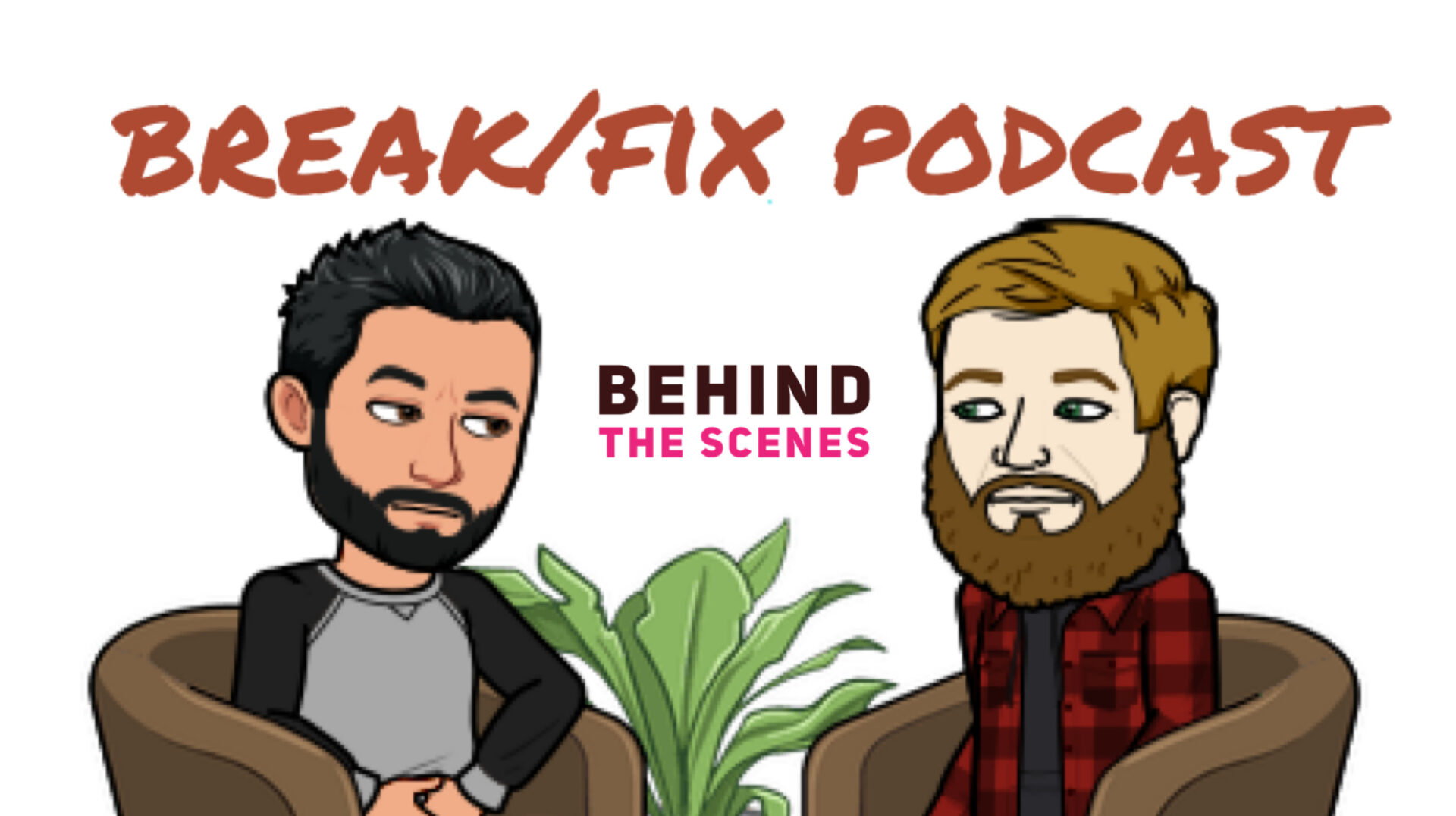
Consider becoming a GTM Patreon Supporter and get behind the scenes content and schwag!
Do you like what you've seen, heard and read? - Don't forget, GTM is fueled by volunteers and remains a no-annual-fee organization, but we still need help to pay to keep the lights on... For as little as $2.50/month you can help us keep the momentum going so we can continue to record, write, edit and broadcast your favorite content. Support GTM today! or make a One Time Donation.

If you enjoyed this episode, please go to Apple Podcasts and leave us a review. That would help us beat the algorithms and help spread the enthusiasm to others by way of Break/Fix and GTM. Subscribe to Break/Fix using your favorite Podcast App:
 |  |  |
There's more to this story!
Be sure to check out the behind the scenes for this episode, filled with extras, bloopers, and other great moments not found in the final version. Become a Break/Fix VIP today by joining our Patreon.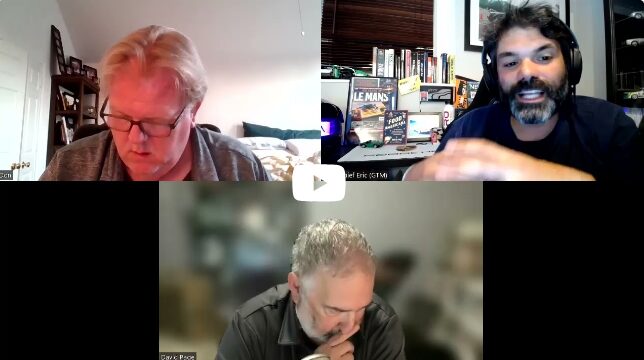
All of our BEHIND THE SCENES (BTS) Break/Fix episodes are raw and unedited, and expressly shared with the permission and consent of our guests.
David Page has pursued his passions both personally and professionally. Creating Diners, Drive-Ins and Dives and hands-on producing its first 11 seasons took him deep into the world of American food – its vast variations, its history, its evolution, and especially the dedicated cooks and chefs keeping it vibrant. His next series, the syndicated Beer Geeks, dove deep into the intersection of great beer and great food. It is those experiences, that education, and the discovery of little-known stories and facts that led David to dig even deeper and tie the strands together in his new book Food Americana.
Food Americana: The Remarkable People and Incredible Stories behind America’s Favorite Dishes (Humor, Entertainment, and Pop Culture)
We love how this book reflects David’s story-telling, like in this episode, it’s knowledgeable, humorous and often with a touch of sarcasm!
To learn more about David Page you can follow him on social media @david.page.1840 on facebook, @pageprod on Twitter and @foodamericana on instagram – and don’t forget to pick up a copy of Food Americana at your local book store or on Amazon today!
There’s more to this story…
Some stories are just too good for the main episode… Check out this Behind the Scenes Pit Stop Minisode! Available exclusively on our Patreon.
Recommended Reads
- Reading List
- Goodreads
Reading List
Goodreads
Guest Co-Host: Don Weberg
In case you missed it... be sure to check out the Break/Fix episode with our co-host. |  |  |


